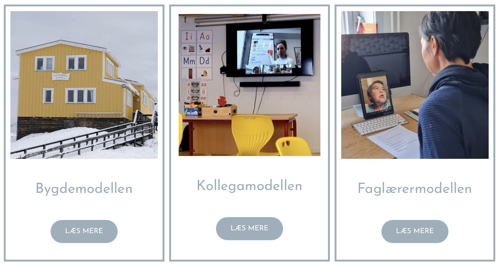Distance learning can help pupils
Following Covid-19, there has been a strong focus on the challenges posed by distance learning
Following Covid-19, there has been a strong focus on the challenges posed by distance learning.
However, it is not this home learning practice that is the focus and experience of this article. It is distance learning in many different ways - but the focus is on a class physically gathered in their own school.

The significant teacher shortage and lack of qualified teachers (especially in small schools in Greenland) makes distance learning a relevant tool. For example, a distance learning teacher from a larger urban school can teach a class in a smaller settlement school - while a class teacher is present to support the process.
This is what we call the settlement model.
A distance teacher can also support another teacher (to get better professional learning going) without being present in the classroom.
This is called the teacher model.
Finally, one or more schools may choose to employ a qualified distance learning teacher themselves.
We call this the colleague model.
In Greenland, the large Kivitsisa project is being implemented. Kivitsisa means "let us lift".
Behind the project are all five municipalities in Greenland, in close cooperation with the Institute of Learning at Ilisimatusarfik and the Agency for Education.
The aim is to significantly raise the level of the Greenlandic primary school through pedagogical and digital methods (all schools, all teachers and all pupils have each received an iPad), as well as focusing on competence development with teachers and managers.
In the project, distance learning has been used in many different ways, and the Institute of Learning has been responsible for collecting the experiences from 16 pilot projects from 2021-2022. The schools, teachers and pupils have implemented various forms of distance learning in different places, at different levels and in different subjects.
They have experimented with teacher and pupil roles, the technical setup, cooperation between schools and, not least, the teaching method itself.
The aim has been to learn how distance learning works best in different situations.
The 'experience collectors' from the Institute of Learning have conducted observations, interviews, experience meetings, conversations, questionnaires, etc. and analyzed this.
We see that distance learning helps the school to become more professional and gives an educational boost. Teachers and pupils are also happy with distance learning, and it helps schools to ensure that pupils receive qualified teaching in all subjects. But, of course, there are potentials and barriers, as well as a lot of day-to-day technical and organizational challenges.
In the team's experience of the Kivitsisa distance learning project, we have seen that good relationships and cooperation between the distance teacher, the pupils, the local teacher and the school management are important ingredients for the success of distance learning. Therefore, we are also working to ensure that the guidance material focuses on the topics where there is a need for further improvement.
We have also seen that well-functioning technology, good organization and explicit choices about didactics have a significant impact on the final outcome of distance learning for pupils.
We have developed guidance material based on the three different models of distance learning - which teachers, schools and municipalities can choose to use or be inspired by:
- The settlement model
- The colleague model
- The teacher model
In addition, we have produced a report that also discusses a number of important themes in distance learning that are particularly relevant for those who organize and manage distance learning - e.g., also at municipal level.
For us in the team, it has been a focal point to look at the experiences gained and to formulate the questions and topics that we as municipal managers of local distance learning projects, as school leaders, and as teachers and distance learning teachers should ask ourselves and our colleagues - and work on, so that it becomes even better for the pupils.
Unlike many other experiences in distance learning and e-learning, the teachers, both those who volunteered and those who were asked to participate, are all interested in continuing distance learning.
They find it meaningful.
It is our belief that the three models are relevant in more contexts than the Greenlandic one. It is relevant for locations with many island schools, with large distances between villages, and in combination with relatively sparsely populated areas. Such as is the case in e.g., the Nordic countries including Denmark.
It is important to be aware that this is a very special knowledge in the field of distance learning and e-learning, which Greenland and the distance learning part of the Kivitsisa project contribute.
The material is of course also translated into Greenlandic.
The five people working on this project are: Ivan Kriegel, Line Groth Nielsen, Louise Pindstrup Andersen, Anders Øgaard and Rikke Ørngreen, all of whom are affiliated with the Institute of Learning at Ilisimatusarfik. Here, Rikke Ørngreen is an adjunct professor in a collaboration with the Institute of Culture and Learning at Aalborg University.













 FACEBOOK
FACEBOOK LINKEDIN
LINKEDIN Copy link
Copy link
